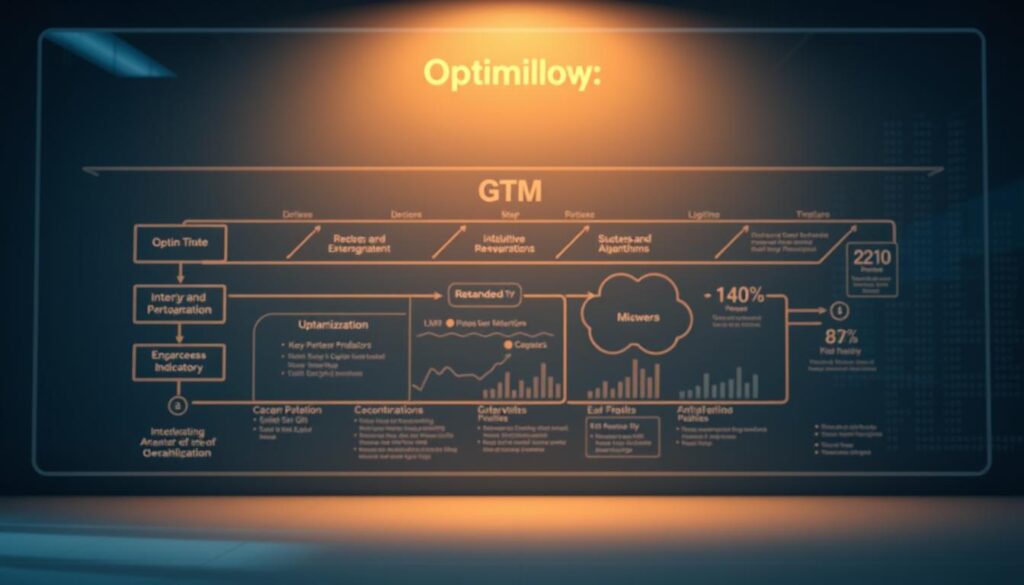In today’s fast-moving work scene, gtm automation for cross-functional collaboration is key for companies looking to improve how they launch products. With a collaboration automation platform, departments like sales, marketing, and product development can unite more easily. This teamwork does more than just make work smoother.
It also means better talks between teams and keeps everyone aiming at the same goals. For businesses wanting to make their go-to-market moves more automatic, using GTM automation is a smart choice. It boosts teamwork and gives firms an advantage over others in the market.
Key Takeaways
- GTM automation enhances collaboration between departments.
- Automating go-to-market processes reduces inefficiencies.
- Collaboration automation platforms ensure alignment among teams.
- Effective communication is vital for successful initiatives.
- Cross-functional collaboration is key to staying competitive.
Understanding GTM Automation
GTM automation mixes technology with auto processes in a company’s market plan. This method boosts teamwork and makes things more efficient across teams. Adopting GTM software solutions is vital as companies face today’s market challenges.
Definition of GTM Automation
Digital tools are used in GTM automation to make launching products or services easier. It helps organize market strategies and links different departments. This means better teamwork and reaching goals together.
Importance in Modern Business
Being quick and flexible is a must in today’s business world. GTM automation lets companies quickly adapt to market shifts and stay competitive. By using strategies with diverse insights, teams work better together. This not only drives innovation but also builds a strong team culture.
Key Components of GTM Automation
Successful GTM automation has key parts, such as:
- Streamlined communication keeping everyone in the loop.
- Data sharing tools for easy access to important info across teams.
- Automated workflows for better task management and using resources well.
These elements help companies use automation to make quicker decisions and boost productivity. GTM automation is key for teamwork in all parts of the operation.
Benefits of GTM Automation for Collaboration
GTM automation brings many benefits that boost team collaboration. It enables organizations to work together more efficiently and cohesively.
Streamlined Communication
With collaboration automation platforms, communication becomes straightforward. This reduces misunderstandings and keeps everyone on the same page. Such clear communication boosts the effectiveness of teams working together.
Enhanced Project Efficiency
Teams work better and faster with GTM workflow optimization. Automated tools streamline project timelines. This helps departments work together smoothly, ensuring projects are completed on time.
Improved Data Sharing
Sharing data effectively is key for making smart decisions. Collaboration automation platforms make important information easy to access for all departments. This improves teamwork and strategic planning.
Tools for Effective GTM Automation
Organizations aiming for successful GTM automation must use the right tools. These tools help teams work together better. Choosing the right ones improves teamwork and project success.
Overview of Popular GTM Tools
Many cross-functional collaboration tools cater to various GTM needs. Platforms like HubSpot, Marketo, and Copy.ai provide special features for gtm automation for cross-functional collaboration. They make work easier and improve team communication, key for good marketing.
Criteria for Selecting the Right Tool
Choosing the best tool for your team involves several factors:
- Scalability: The tool should grow with your team’s needs.
- Ease of Use: It must be easy for everyone to use.
- Integration Capabilities: It should work well with your current systems.
Integration with Existing Systems
For a collaboration automation platform to work, it must blend with existing workflows well. Tools that integrate easily make switching smoother. This helps organizations meet their GTM goals with less trouble.
Best Practices for Implementing GTM Automation
To effectively implement GTM automation, it’s key to follow best practices that fit your organization’s needs. These practices help businesses make big improvements in how they work and communicate across different teams.
Setting Clear Objectives
It’s vital for organizations to set specific, measurable goals to boost teamwork with automation. These objectives should focus on improving efficiency, productivity, and team alignment. Having clear goals is the foundation for successful GTM automation, making sure everyone knows their role and duties.
Involving Cross-Functional Teams
Bringing in cross-functional teams from the start makes sure various viewpoints are included. This approach encourages teamwork and support, which greatly increases the chances for successful automation. It’s important to have activities that let different teams share their thoughts, improving the GTM process.
Monitoring and Optimization
Keeping an eye on and fine-tuning the automation is crucial to see how things are going. By regularly checking in, organizations can see what’s working and what needs to be fixed. Using Key Performance Indicators (KPIs) helps track progress and make necessary adjustments. Staying committed to making things better allows companies to boost teamwork and efficiency through automation.

| Best Practice | Description | Impact |
|---|---|---|
| Clear Objectives | Define specific goals to guide implementation. | Focuses efforts and measures success. |
| Team Involvement | Engage diverse teams in the process. | Improves buy-in and input quality. |
| Monitoring | Regularly assess performance using KPIs. | Identifies areas for improvement and ensures adaptation. |
Challenges and Solutions in GTM Automation
Organizations that try to use gtm software often face challenges. They might struggle with people not wanting to change, not knowing how to use the software, or the software not working with their current tools. Knowing about these problems is the first step to fixing them and making teamwork better.
Common Obstacles Teams Face
Some challenges include:
- Resistance to Change: Workers might not want to try new tech because they like how things are now.
- Lack of Training: If people don’t get enough training, they won’t know how to use the gtm software well.
- Integration Issues: Sometimes, the new software doesn’t fit well with the old tools, which can cause issues.
Strategies to Overcome Challenges
There are ways to fix these issues:
- Give a lot of training and support so everyone feels good using new tools.
- Show how automation helps everyone work together better by sharing its benefits.
- Choose AI tools that easily work with what the company already uses.
Case Studies of Successful Adaptations
Many groups have beaten these challenges. For instance, companies using advanced gtm software like Copy.ai show that automation can make work easier. They’ve improved how teams work together by adding AI. Their stories show us how AI can make work easier and help us tackle problems. Find out how AI changes teamwork in marketing.
Measurement and Metrics for Success
Measurement and metrics are vital for a good GTM automation plan. They help businesses keep an eye on their efforts to make GTM workflow better. By looking at the right Key Performance Indicators (KPIs), teams can understand how well they’re doing. This includes checking how fast projects are done, how well everyone communicates, and how quickly they use data.
Key Performance Indicators (KPIs) to Track
It’s key to know which KPIs to watch. This tells you if your automated tools for working together are doing well. Think about:
- Project Completion Rate: Evaluating how often projects meet deadlines.
- Communication Efficiency: Measuring the speed and clarity of information sharing.
- Response Time: The time taken for team members to react to queries or requests.
Analyzing Results and Feedback
Looking at results often and asking for team input is very helpful. This lets companies interested in better collaboration through automation see how things are really going. Talking with the team helps identify problems and places to get better. Through surveys and talks, teams can understand expectations versus actual outcomes.
Adjusting Strategies Based on Data
Using data from KPIs and feedback helps businesses tweak their GTM plans. Leaders should change methods that don’t work as hoped. Focusing on changes based on data makes tools work better and fit into daily work more smoothly. This lets organizations change quickly, keeping up with their main goals.

Future Trends in GTM Automation
The world of GTM automation is changing fast, with new advances in artificial intelligence and machine learning. These technologies are changing how teams work together, especially when different parts of a business come together. With AI in GTM tools, companies can now predict trends better and make smart decisions faster. This leads to better plans and team work.
The Role of AI and Machine Learning
AI and machine learning are more than just popular terms. They are key to using collaboration automation platforms efficiently. They dig through lots of data to suggest actions. This means teams can make choices based on solid data, making their work smoother and improving communication across different departments.
Predictions for Cross-Functional Collaboration
As companies keep innovating, there’s a big focus on being quick and flexible when teams from different parts of the business work together. Adding AI and machine learning to GTM strategies helps companies adjust quickly to changes in the market. Being able to change quickly not only makes work more efficient but also encourages teamwork, crucial for staying ahead in today’s market.
Adapting to Evolving Business Environments
To succeed today, companies need to stay adaptable and keep updating their strategies. Using new technologies well is important for improving GTM activities. By making the most of automation tools, businesses can work together better and reach their targets in a changing business world.
FAQ
What is GTM Automation?
GTM Automation uses automated tools and processes to improve teamwork across different departments. This helps boost communication, streamline tasks, and get teams working towards the same goals.
Why is GTM Automation important for modern businesses?
In today’s quick-moving world, GTM Automation helps break down barriers between teams like sales, marketing, and product development. It encourages teamwork and helps companies quickly adjust to new market trends.
What are the key components of GTM Automation?
Key parts of GTM Automation are smooth communication channels, data sharing tools, and automated workflows. Together, they help manage projects better and boost overall productivity.
What are the benefits of implementing GTM Automation?
Benefits include better communication, more efficient project management, and improved data sharing. These lead to stronger teamwork and smarter decisions across various teams.
What tools are commonly used for GTM Automation?
Well-liked tools for GTM include HubSpot, Marketo, and Copy.ai. They support different aspects of the go-to-market process and automate collaboration across departments.
How should organizations choose the right GTM tools?
When picking GTM tools, companies should look at scalability, how easy they are to use, and if they work well with current systems. This ensures a smooth start that fits their way of working.
What best practices should be followed for successful GTM Automation?
For success, it’s key to have clear goals, get different teams involved in starting up, and keep an eye on automation efforts by using KPIs. This helps make automation work better.
What challenges can arise during GTM Automation implementation?
Challenges might include resistance to change, needing more training, and issues with integrating systems. It’s vital to tackle these issues for automation to succeed in team collaborations.
How can organizations overcome challenges in GTM Automation?
Organizations can offer thorough training and support. They should also clearly communicate GTM Automation’s benefits to help everyone adapt more easil



